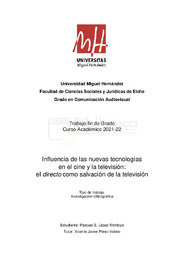Por favor, use este identificador para citar o enlazar este ítem:
https://hdl.handle.net/11000/28064Registro completo de metadatos
| Campo DC | Valor | Lengua/Idioma |
|---|---|---|
| dc.contributor.advisor | Pérez Valero, Vicente Javier | - |
| dc.contributor.author | López Montoya, Pascual E. | - |
| dc.contributor.other | Departamentos de la UMH::Ciencias Sociales y Humanas | es_ES |
| dc.date.accessioned | 2022-10-27T10:01:12Z | - |
| dc.date.available | 2022-10-27T10:01:12Z | - |
| dc.date.created | 2022-06-21 | - |
| dc.identifier.uri | https://hdl.handle.net/11000/28064 | - |
| dc.description.abstract | Este trabajo tiene como finalidad esclarecer cuáles han sido los cambios significativos en los procesos de evolución en formatos audiovisuales como el cine y la televisión, sus nuevas propuestas de visionado, entender la particularidad del medio y el directo como soporte de la televisión, concretamente los programas de carácter deportivo, siendo los orientados al fútbol y retransmisiones de partidos el eje central del mismo. Cabe reseñar que la crisis de la COVID-19 ha provocado también cambios técnicos, extremo que tiene su apartado y es expuesto. Recurre a la revisión bibliográfica, entrevistas a profesionales tanto del cine como de la televisión y a la experiencia profesional del autor, hechos que han permitido, dentro del campo de estudio, delimitar el área, verificar el estado de la cuestión, la función de las nuevas tecnologías incorporadas dentro de un marco teórico del cine y la televisión, y cómo éstas han influido en la dirección y realización audiovisual y su estructura narrativa. | es_ES |
| dc.description.abstract | The aim of this work is to shed light on the significant changes in the processes of evolution in audiovisual formats such as cinema and television, their new viewing proposals, to understand the particularity of the medium and live television as a support for television, specifically sports programmes, with those oriented towards football and match broadcasts being the central axis of the same. It should be pointed out that the COVID-19 crisis has also provoked technical changes, a point that has its own section and is explained. The bibliographical review, interviews with film and television professionals and the author's professional experience have allowed, within the field of study, to delimit the area, verify the state of the question, the function of the new technologies incorporated within a theoretical framework of film and television, and how these have influenced audiovisual direction and production and its narrative structure. | es_ES |
| dc.format | application/pdf | es_ES |
| dc.format.extent | 66 | es_ES |
| dc.language.iso | spa | es_ES |
| dc.publisher | Universidad Miguel Hernández de Elche | es_ES |
| dc.rights | info:eu-repo/semantics/openAccess | es_ES |
| dc.rights | Attribution-NonCommercial-NoDerivatives 4.0 Internacional | * |
| dc.rights.uri | http://creativecommons.org/licenses/by-nc-nd/4.0/ | * |
| dc.subject | televisión | es_ES |
| dc.subject | cine | es_ES |
| dc.subject | narrativa | es_ES |
| dc.subject | formatos | es_ES |
| dc.subject | Internet | es_ES |
| dc.subject | reproducción | es_ES |
| dc.subject | television | es_ES |
| dc.subject | cinema | es_ES |
| dc.subject | narrative | es_ES |
| dc.subject | formats | es_ES |
| dc.subject | reproduction | es_ES |
| dc.subject.other | CDU::3 - Ciencias sociales::31 - Demografía. Sociología. Estadística::316 - Sociología. Comunicación | es_ES |
| dc.title | Influencia de las nuevas tecnologías en el cine y la televisión: el directo como salvación de la televisión | es_ES |
| dc.type | info:eu-repo/semantics/bachelorThesis | es_ES |

Ver/Abrir:
TFG-Lopez Montoya, Pascual E..pdf
4,72 MB
Adobe PDF
Compartir:
 La licencia se describe como: Atribución-NonComercial-NoDerivada 4.0 Internacional.
La licencia se describe como: Atribución-NonComercial-NoDerivada 4.0 Internacional.
.png)